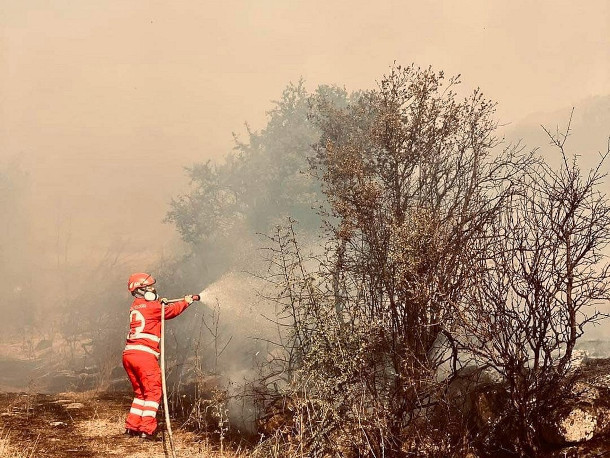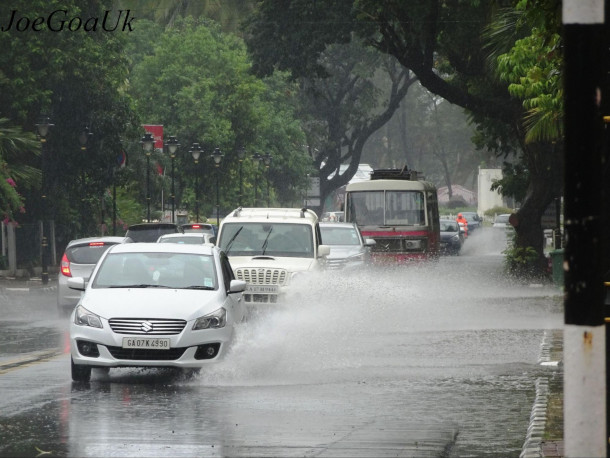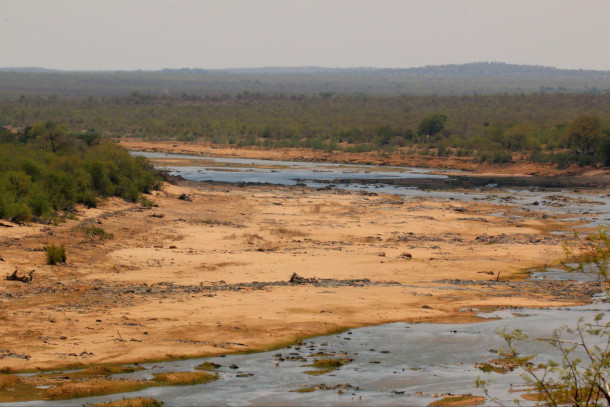Earth’s Fever
Air Date: Week of November 15, 2024

Greenhouse gas emissions from the burning of fossil fuels have trapped an increasing amount of heat in the atmosphere, leading to a 1.2 0 Centigrade rise in average surface global temperature. (Photo: Ian Barbour, Flickr, CC BY-SA 2.0)
Although the global average temperature has been steadily increasing for decades, in 2023 there was a sudden jump of 0.2 degrees Celsius. This has raised alarm among climate scientists about how fast the climate crisis is progressing. Dr. Jennifer Francis is Senior Scientist at the Woodwell Climate Research Center, and she joined Living on Earth’s Jenni Doering to discuss the temperature spike and its implications.
Transcript
BELTRAN: It’s Living on Earth, I’m Paloma Beltran.
O’NEILL: And I’m Aynsley O’Neill.
Scientists monitoring earth’s climate have identified a concerning trend in global warming starting in April 2023. While climate change has been steadily heating up the planet for decades, in 2023 global average temperatures suddenly jumped by about 0.2 degrees Celsius and have remained elevated. The spike in temperature has raised alarm among climate scientists about how fast the climate crisis is progressing as they scramble to explain Earth’s worsening fever. Dr. Jennifer Francis studies climate and weather in the Arctic at the Woodwell Climate Research Center and has had her eyes on the planet’s rising temperature for decades now. She joined Living on Earth’s Jenni Doering to discuss the recent uptick in heating and what it could mean for the fight against climate change.
DOERING: So, let's start from the beginning. What's so abnormal about this temperature spike observed in the last couple of years that's raising concerns among researchers?
FRANCIS: Yeah, so there are many factors that come into play in creating both last year 2023 and again this year, breaking, really temperature records for the globe going back as far as we have records. So, we can estimate the temperature going back quite aways. And we're pretty sure that this past July in 2023 and then broken again in 2024 are really the warmest we've seen in many hundreds of years. So, this is quite concerning, and we know what's going on. I mean, the earth actually should be cooling right now, if it were only natural causes at play. But we know that, because we've been adding so many heat trapping greenhouse gasses to the atmosphere over the last several decades, that these heat trapping gasses are indeed keeping a lot more heat in the climate system than we should have right now. So, what's going on is that we're seeing some very large and intense marine heat waves in various parts of the global ocean, and those are the result of that heat being trapped by those greenhouse gasses. It gets stored in the ocean, about 90% of it goes into the ocean, and now we're seeing some of that heat coming back out and going into the atmosphere.

2023 was the hottest year on record and 2024 is set to be even warmer. Throughout the year, this intense heat has led to a number of natural disasters, including wildfires in Greece back in August. (Photo: Climate Center, Flickr, CC BY-NC 2.0)
DOERING: Now I understand that this spike in temperature is only about 0.2 degrees Celsius. That doesn't sound like much. Why does that number mean so much to climate scientists?
FRANCIS: Yes, well, it doesn't sound like much, and certainly any individual in any location would not really notice it. But in fact, this is a lot for the average over the entire globe. And if we look back at the natural fluctuations that have happened to the Earth's temperatures, going back 1000s of years, we know that it doesn't take very much to shift the globe from an ice age and the opposite, which we call an interglacial, this is a relatively warm period in the earth's temperature natural cycle. That's only three degrees Celsius difference. So, it really doesn't take a lot of temperature change in terms of absolute degree Celsius, to make a huge difference in what the climate system feels, what the living part of the Earth system feels. It can have huge impacts on things like weather and changes in ice and changes in plants and agriculture, because that small change in temperature globally gets translated to big changes in things like the atmosphere and ocean currents and things like that.

Flooding has become a regular reality for some cities and towns that are prone to heavy precipitation or coastal surges. (Photo: Joegoauk Goa, Flickr, CC BY-SA 2.0)
DOERING: What are some of the other theories or explanations that are being proposed for this recent temperature rise?
FRANCIS: Yeah, so this recent temperature rise is mainly caused by the increasing amounts of heat trapping greenhouse gasses that we've been putting into the atmosphere. That is the a number one cause, and the earth should be cooling right now, but instead, we're seeing this incredibly rapid increase in global temperatures and sea surface temperatures. So, some of the other factors that are playing a very much smaller role than the greenhouse gas increases are decreases in the amount of particles that are in the air that we've been putting in by burning fossil fuels, by forest fires, by volcanoes, by pollution from industry. So, there's been a decrease in the amount of those particles, and that plays a role, because those particles tend to reflect some of the sun's energy that's coming in, and that helps by having fewer of those particles, more of the sun's energy is making it into the climate system. So that's one minor role, also starting in April 2023 an El Nino started to develop. El Nino is basically a pattern of ocean temperatures that we see coming and going every few years, and we know that when an El Nino comes along, we tend to see increases in the global average temperature. And indeed, we saw that. But this is well beyond what an El Nino should do. Another potential cause, although I'd say the jury is still out, is the recent eruption of the volcano in Tonga, which is an island group in the South Pacific, and that put a lot of extra water vapor, moisture in the atmosphere. And water vapor is a greenhouse gas, so that potentially could have added to the greenhouse effect. But it's been generally shown that that effect is relatively small as well. So, really it comes down to the fact that we've been adding all of these greenhouse gasses to the atmosphere for decades by mostly burning fossil fuels, but also cutting down forests, removing mangrove trees along coastlines, getting rid of wetlands, all of these natural ways that the climate system can remove things like carbon dioxide from the atmosphere and help offset the effects of those heat trapping gasses.
DOERING: Sounds like things are really catching up with us.
FRANCIS: Yes, indeed. And this is not a surprise.
DOERING: Not a surprise, you say, but it sounds like there are climate scientists who are scratching their heads and saying, why are the numbers not lining up with what we expected? So, what's going on there?
FRANCIS: So, I would argue actually, that these numbers are not out of line with what we should have expected when we look at the simulations by these very complicated computer models that we use to project what the climate system is going to do. These models, they fluctuate just like the Earth's real climate does, around this trend line that's caused by the increasing greenhouse gasses, and those fluctuations in the model simulations are within the range of the spike that we saw last year and this year. So, it's really not out of the realm of expectations to see a spike like this. And in my mind, anyway, I don't think there's really a big surprise here.

Higher levels of heat in the atmosphere cause more frequent and severe droughts, and intensify droughts linked to other causes. (Photo: Water Alternative Photos, Flickr, CC BY-NC 2.0)
DOERING: You know, the current national plans from governments to reduce carbon emissions would still result in around three degrees Celsius of warming, far more than the Paris Climate Agreement goal of 1.5 degrees C. So how does this recent temperature spike and this increase we're seeing long term relate to how nations should be thinking about their climate ambition?
FRANCIS: Yeah, well, you know these spikes in temperatures? Well, they're not surprising. They are kind of a wakeup call. And not just the temperatures, but the increases in extreme weather events that we've been observing increasing not only in the number of them, but how much damage they're doing, how intense they are, how much area they're covering, how many areas are being affected by these extreme events. So yes, heat waves are a big part of that, and connected to heat waves, often are droughts. We've seen some very severe droughts emerging and increasing, and both of those together are the recipe for wildland fires. We've seen a big increase in fires, which is a big concern, not because of the damage they do, but also because they release a lot more carbon containing gasses into the atmosphere, which just makes the whole global warming problem worse. We've seen yet another unprecedented flooding event unfolding in Spain, which follows on the heels of some incredible flooding that we've seen in our own country, here in Asheville, North Carolina, and up in Vermont and Maine and places that usually you think of being relatively immune to the major impacts of climate change. So, we have to really get on the stick here. The commitments that were made in Paris we knew were not going to be enough. But not only are we not meeting those insufficient targets, but we're falling behind even farther. And so, the expectation is that we'll blow right by the 1.5-degree target that was ambitious in Paris, but probably heading more towards three degrees. And we've already seen what these extreme events are doing, even with 1.2 degrees Celsius warming on average. So yeah, this is, I hope, a big wake up call for countries and for the public who vote for leaders who are making these decisions in these countries.

A protest of newly approved coal mines in Melbourne. (Photo: Flickr, John Englart, CC BY-SA 2.0)
DOERING: You've been studying this for decades now and sounding the alarm for quite some time. What keeps you going in this work? I mean, it must be tiring.
FRANCIS: Yes. I mean, every day you wake up and you read about another extreme weather event, because I study extreme weather, of course, that's what I pay attention to most closely. But what gives me hope to carry on is knowing that my research is helping communities understand what is possible in the future, what these extreme events are going to do in the future, and how they might affect various areas. I also see young people really charged up to figure out ways to reduce the severity of the climate crisis, and not just by becoming scientists or engineers, but by going into law, for example, and changing policy. People studying art that help the public understand in different ways, without just listening to the news and understanding the science, but reaching people through art, for example. Writers doing a better job of communicating the science, and also when an extreme event, like we were seeing recently, when those events happen, translating it better to the public to understand the fact that climate change is making these sorts of things more intense and more concerning. I mean, there's all kinds of ways for people to get involved. And to help make a difference. So, as we go forward, we can make this problem a little less bad.
O’NEILL: That’s Senior Scientist Jennifer Francis of the Woodwell Climate Research Center speaking with Living on Earth’s Jenni Doering.
Links
Read about Dr. Jennifer Francis’ Research on the Arctic Climate
Listen: Dr. Jennifer Francis’ comment on the 2023 Climate Record
NASA | “NASA Analysis Confirms 2023 as Warmest Year on Record”
Living on Earth wants to hear from you!
Living on Earth
62 Calef Highway, Suite 212
Lee, NH 03861
Telephone: 617-287-4121
E-mail: comments@loe.org
Newsletter [Click here]
Donate to Living on Earth!
Living on Earth is an independent media program and relies entirely on contributions from listeners and institutions supporting public service. Please donate now to preserve an independent environmental voice.
NewsletterLiving on Earth offers a weekly delivery of the show's rundown to your mailbox. Sign up for our newsletter today!
 Sailors For The Sea: Be the change you want to sea.
Sailors For The Sea: Be the change you want to sea.
 The Grantham Foundation for the Protection of the Environment: Committed to protecting and improving the health of the global environment.
The Grantham Foundation for the Protection of the Environment: Committed to protecting and improving the health of the global environment.
 Contribute to Living on Earth and receive, as our gift to you, an archival print of one of Mark Seth Lender's extraordinary wildlife photographs. Follow the link to see Mark's current collection of photographs.
Contribute to Living on Earth and receive, as our gift to you, an archival print of one of Mark Seth Lender's extraordinary wildlife photographs. Follow the link to see Mark's current collection of photographs.
 Buy a signed copy of Mark Seth Lender's book Smeagull the Seagull & support Living on Earth
Buy a signed copy of Mark Seth Lender's book Smeagull the Seagull & support Living on Earth

